Rest and recovery are key in getting fit. They let the body fix and make muscles stronger. But, did you know you can still exercise on rest days without hurting recovery?
Low-impact exercises are soft yet effective for supporting recovery and keeping fit. They improve your heart, make you more flexible, and strengthen muscles. Whether healing from hurt or avoiding injury, these workouts keep you moving and feeling good.
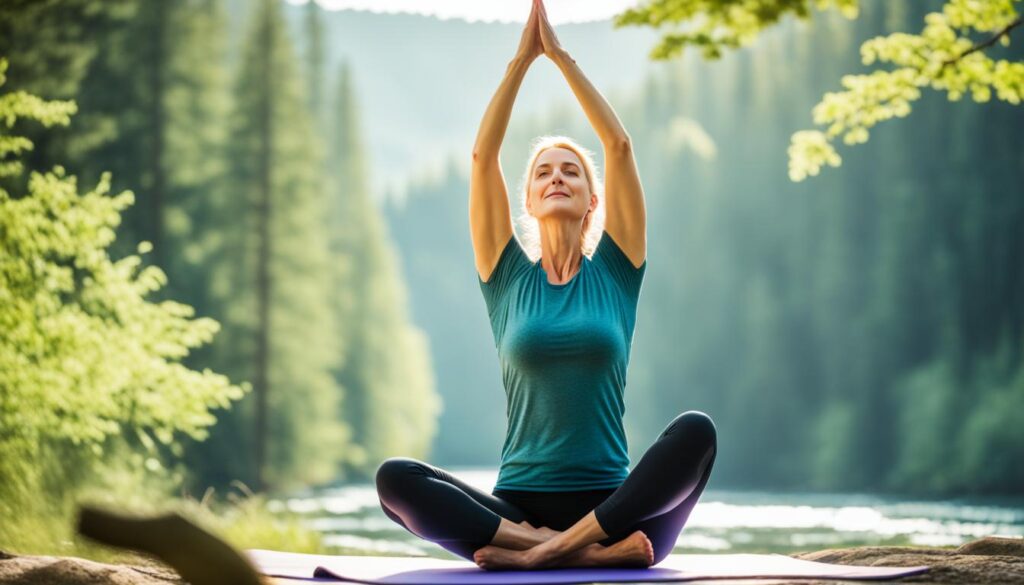
Key Takeaways:
- Low-impact exercises are great for healing from injuries and staying fit while not harming muscle repair.
- Walking, hiking, yoga, Pilates, Tai Chi, barre, swimming, elliptical training, cycling, rowing, strength training, stretching, massage, foam rolling, and sauna are all awesome low-impact choices.
- They boost heart health, enhance flexibility, build muscles, and help you relax.
- Listen to what your body says, keep your form correct, and talk to doctors for the best exercise advice when injured.
- The right low-impact exercises can make you return to what you love, stronger than before.
Walking for Injury Recovery and Fitness
Walking is an excellent choice for recovering from injuries and staying fit. It’s easy on the body and very beneficial. Let’s look at why walking is so good for you.
Benefits of Walking
Walking helps both your body and mind. It has many benefits, such as:
- **Walking for injury recovery:** It boosts blood flow, helping injuries heal faster.
- **Maintaining fitness:** Walking keeps your weight in check, strengthens your immune system, and lowers disease risk.
- **Low-impact workout:** It’s easy on the joints, perfect for injury recovery or if you have joint pain.
- **Improved mood:** Walking lifts your spirits by releasing endorphins, lowering stress and anxiety.
Walking can be tailored to your fitness level. You can adjust how often, how far, and how fast you walk to meet your goals.
Walking vs. Running
| Walking | Running | |
|---|---|---|
| Impact on Joints | Low impact | High impact |
| Calorie Burn | Depends on speed and distance | Higher calorie burn |
| Aerobic Benefits | Boosts heart health | Offers more aerobic benefits |
| Muscle Engagement | Focuses on lower body muscles | Works multiple muscle groups |
Walking Tips for Injury Recovery and Fitness Maintenance
Follow these tips to enhance your walking:
- Start with short walks and slowly extend them as you get fitter.
- Choose comfy shoes with good support and cushioning.
- Walk with good posture—head up and shoulders relaxed.
- If injured, talk to a doctor about how much walking is right for you.
- Try walking to work, using the stairs, or going for walks during breaks to fit more walking into your day.
Even though walking is low-impact, it’s very beneficial for your health. It’s great for injury recovery and keeping fit. Walking helps you stay active and live a healthy life.
Hiking for Injury Recovery and Fitness
Hiking is a great low-impact exercise for both injury recovery and keeping fit. It gives you a chance to enjoy nature and refresh yourself. You can choose from easy walks to tough climbs, based on what you like and your fitness goals.
Hiking is perfect for people getting over injuries. It’s low-impact, so it doesn’t stress your joints and muscles too much. This means you can stay active without hurting your recovery. It’s a safe way to exercise and avoid getting hurt again.
Hiking improves your overall fitness too. It’s an excellent way to work your heart and build endurance. Different trails work out various muscles, making you stronger and toned. Plus, it’s good for your bones, fighting off conditions like osteoporosis.
Hiking can be easy or hard, depending on what you want. There are simple trails for a light walk. For a bigger challenge, you can pick trails with steep climbs. This lets you adjust the activity to match your fitness level and what you enjoy.
But hiking isn’t just good for your body. It also helps your mind. Being outdoors reduces stress, lifts your mood, and makes you happy and relaxed. Completing a tough hike can make you feel proud and fulfilled.
The Benefits of Hiking for Injury Recovery and Fitness:
- Low-impact exercise for injury recovery
- Cardiovascular improvement
- Muscle strengthening and toning
- Weight-bearing exercise for bone density
- Versatile activity for different fitness levels
- Mental well-being and stress reduction
Hiking is great for injury recovery or if you’re looking for a low-impact exercise. It combines physical activity with the outdoors, benefiting your body and mind. So, get your hiking boots ready, pack your bag, and explore the trails for a fulfilling experience.

Yoga and Pilates for Injury Recovery and Fitness
Yoga and Pilates are two gentle exercises great for injury recovery and staying fit. They improve your flexibility, strength, and balance. This is ideal for rest days or rehab programs.
Yoga combines physical postures, breathing, and meditation. It boosts flexibility, posture, and how your joints move. Plus, it brings peace, lowers stress, and supports mental health. This connects your mind and body beautifully.
Pilates focuses on your core strength, stability, and conditioning your body. It uses controlled moves and breathing to better your posture, muscle tone, and flexibility. By strengthening weak muscles and aligning your body, Pilates helps prevent injuries.
Both these practices can be tailored to fit your own needs and skill level. Whether at home, in a studio, or with an instructor, yoga and Pilates are flexible. Some well-known poses are:
- Downward Facing Dog
- Warrior I and II
- Bridge Pose
- Plank
- Tree Pose
- Single Leg Stretch (Pilates)
- Leg Circle (Pilates)
- Spine Stretch (Pilates)
Remember, you can adjust yoga and Pilates to fit your fitness or heal injuries. Always pay attention to how your body feels. Talk to a doctor or a trained instructor to make sure you’re doing it right and safely.
Adding yoga and Pilates to your routine offers many benefits for low-impact flexibility and injury recovery. These activities also boost your strength and bring a calming effect to your life.

Tai Chi and Barre for Injury Recovery and Fitness
Tai Chi and Barre offer great ways to get better after an injury. They also keep you fit. These exercises improve your balance, muscle tone, and flexibility. They also make your posture better.
Tai Chi: Promoting Balance, Coordination, and Relaxation
Tai Chi comes from ancient China. It’s slow and gentle. It uses flowing movements and deep breaths to calm you and better your balance. Tai Chi is great for healing because it’s easy on your body.
Doing Tai Chi often improves your body and mind. It also lowers stress and anxiety. It’s great for healing and keeping peace within.
Barre: A Fusion of Ballet, Yoga, and Pilates
Barre mixes ballet, yoga, and Pilates. It uses a barre for small, exact movements. This targets muscles to improve tone, flexibility, and posture.
In a barre class, you work on your core, legs, butt, and arms. Barre is easy on the joints. It’s good for anyone healing from injuries.
Barre focuses on staying aligned, which helps your posture. It lowers the chance of getting hurt again. Ballet moves and fun music make it exciting.
Tai Chi and Barre are great for getting better and staying fit. They’re easy on the body. Adding them to your routine is good for your health.
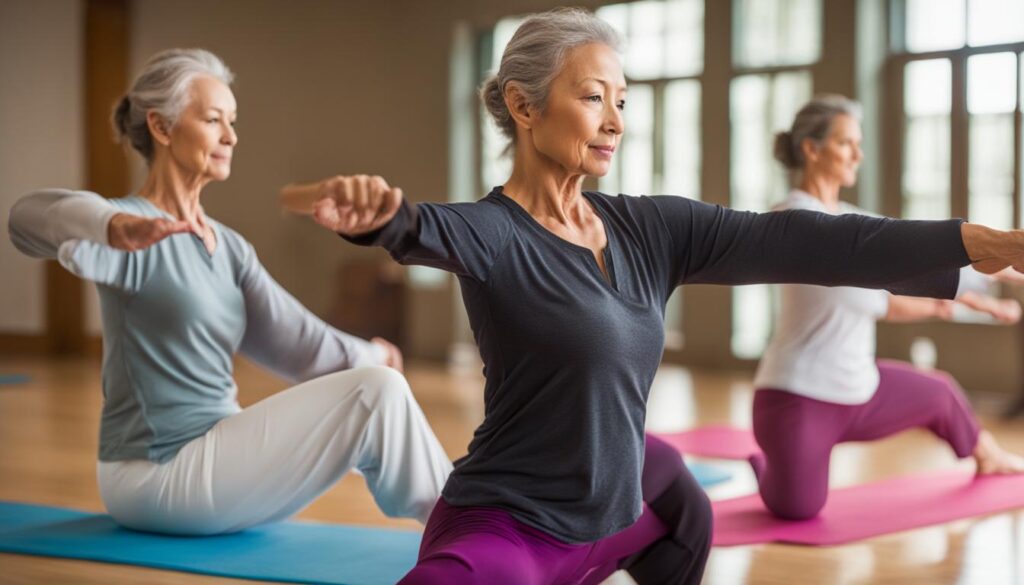
The next section will talk about swimming and elliptical training. These are also low-impact exercises. They help with injury recovery and keeping fit.
Swimming and Elliptical Training for Injury Recovery and Fitness
Swimming and elliptical training are great low-impact cardio workouts. They are perfect for healing injuries and staying fit. Each one has its own special benefits. So, they are top picks for those looking for easy but effective exercises.
The Benefits of Swimming
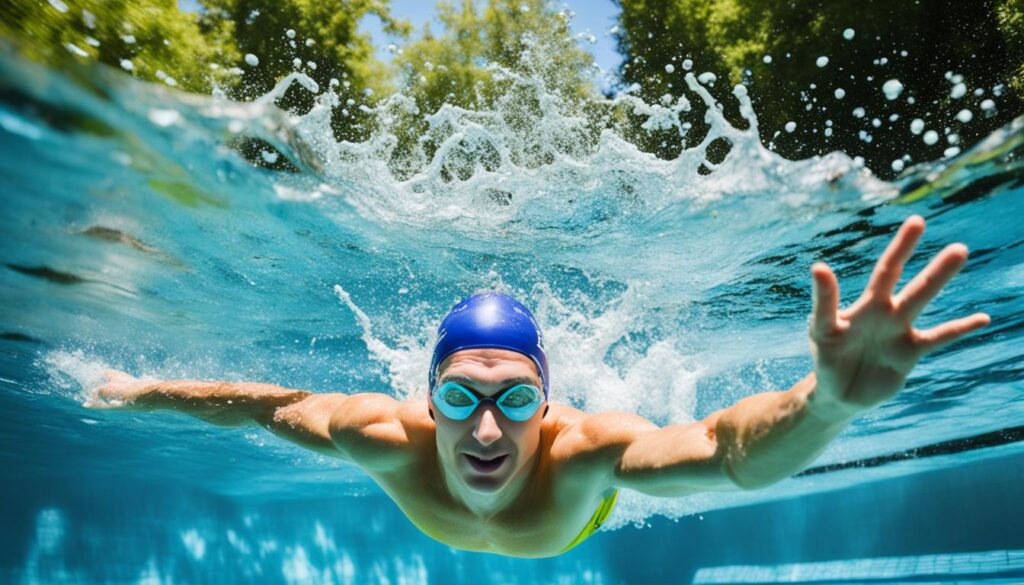
Swimming for injury recovery is gentle on your body. It lets you build strength without hurting injured spots. The water holds you up. This eases pressure on your joints which helps a lot when you’re getting better.
Swimming is also awesome for your heart and lungs. It works out lots of muscles at the same time. This makes you stronger and more enduring. Plus, the water limits chances of getting hurt again.
The Benefits of Elliptical Training
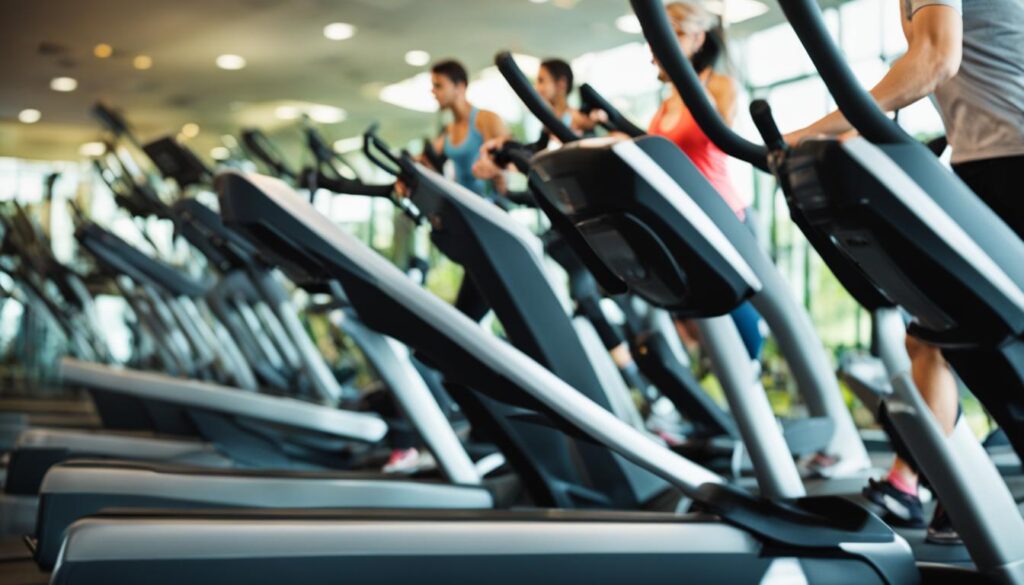
Elliptical training is another soft way to exercise for injury recovery. It’s easy on the joints, perfect for people with injuries or joint issues. It copies walking or running but with less impact. So, it’s a great way to get your heart rate up safely.
Ellipticals work both your upper and lower body at once. This boosts muscle strength and heart fitness. You can even change the workout’s intensity. This makes it ideal for different fitness levels and healing needs.
Incorporating Swimming and Elliptical Training into Your Fitness Routine
Adding swimming and elliptical workouts to your routine is simple. Start with short sessions and up the time and hard work as you get better. This approach helps you recover and stay fit efficiently.
Always listen to your body and get advice from health or fitness pros. They can guide you on the correct way to do exercises safely. They can suggest special exercises or adjustments for your healing process.
With swimming and ellipticals in your routine, you’ll heal well. You’ll also boost your heart health and keep fit without hurting your recovery journey.
Cycling and Rowing for Injury Recovery and Fitness
Cycling and rowing are superb for getting fit and healing injuries. They’re great for your heart and building endurance, but easy on your body.
Cycling: You can cycle outside or inside on a stationary bike. It’s a safe way to boost fitness and heal. It strengthens your legs, boosts lung health, and is gentle on joints. Perfect for those healing from injuries.
Rowing: Rowing works out your whole body at once. It’s gentle on your joints but great for the heart. It strengthens muscles, boosts endurance, and helps with balance. Plus, you can change the resistance to match your fitness level.
The Benefits of Cycling and Rowing:
Both offer big pluses for healing and getting stronger:
- Low-Impact: They’re easy on your body, cutting down on joint stress and injuries.
- Cardiovascular Health: They’re awesome for your heart and stamina.
- Endurance Building: They make you stronger and improve your fitness.
- Muscle Strengthening: Cycling focuses on your legs. Rowing works out your legs, back, and arms.
- Weight Management: They help you burn calories and manage weight.
Choosing cycling or rowing will speed up your recovery and boost your fitness.
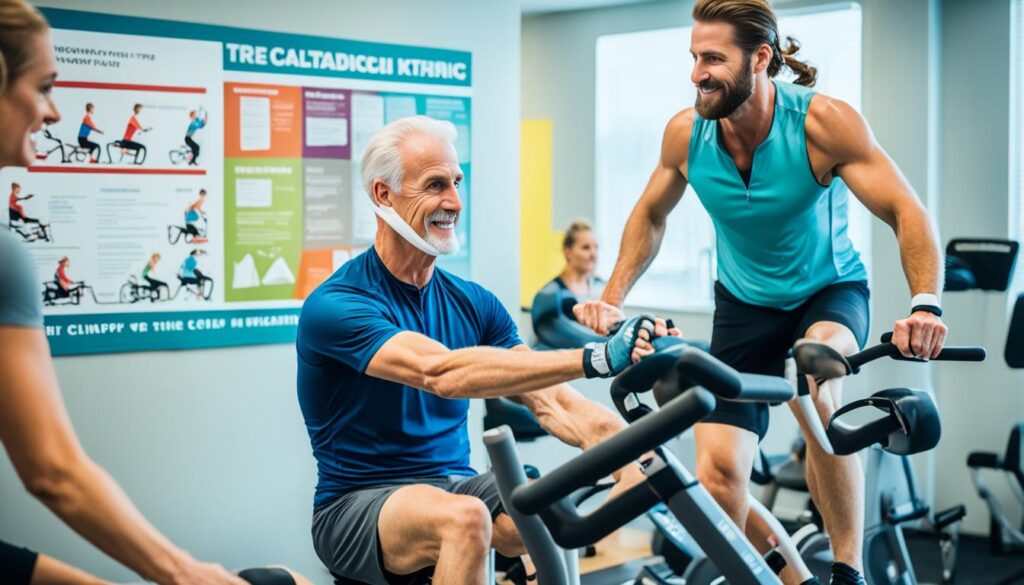
| Cycling | Rowing | |
|---|---|---|
| Primary Muscle Groups | Legs (quadriceps, hamstrings, calves) | Legs (quadriceps, hamstrings, calves), back muscles, arms, core |
| Cardiovascular Benefits | Improves heart health, increases stamina | Improves heart health, increases stamina |
| Joint Impact | Low impact, reduces stress on joints | Low impact, reduces stress on joints |
| Calorie Burn | Burns calories for weight management | Burns calories for weight management |
| Adjustable Resistance | Can adjust resistance levels for different intensity levels | Can adjust resistance levels for different intensity levels |
Strength Training for Injury Recovery and Fitness
Strength training aids in healing and keeping fit. Though some think it’s too intense for recovery, low-impact options work well. These exercises help muscles heal.
On your off days, try bodyweight exercises like squats, lunges, and push-ups. They target important muscles that might get overlooked. And they do so without stressing your joints.
Strength training has several benefits for your fitness. It boosts bone density, crucial during and after injury. Stronger bones mean less risk of future harm.
It’s also great for your joints. Strength training builds muscles around joints, aiding in stability. This lowers the chance of new injuries and enhances joint function.
Moreover, it improves overall muscle tone and strength. This support helps during physical activities. It also prevents imbalances that could cause injuries. You can make sure your whole body stays strong and functional.
“Strength training is a valuable component of injury recovery and fitness maintenance.”
Adding strength training to your routine helps with injury recovery and keeps you fit. Always check with a healthcare professional or fitness trainer. They’ll make sure your exercises and form are correct, preventing more injuries.

Stretching and Massage for Injury Recovery and Fitness
Stretching and massage are key for injury recovery and staying fit. They help with flexibility, movement, muscle ease, and reducing ache. They are good for both getting over an injury and boosting your fitness game.
Benefits of Stretching
Stretching for injury recovery is a must. It betters flexibility and movement. By stretching, you can focus on muscles and joints hit by injuries. It boosts blood flow, cuts down stiffness, and speeds up healing. Plus, stretching pre and post workouts ups your performance and keeps muscles healthy.
To get the benefits of stretching, mix in dynamic stretching before working out to warm up. And do static stretching after to cool down and get more flexible. Make sure to breathe well and hold stretches for 15-30 seconds without going too far. Pay extra attention to areas like the hamstrings, quadriceps, calves, and shoulders.
The Power of Massage
Massage is great for injury recovery too. It helps muscles relax, boosts blood flow, and lowers swelling. It eases muscle tension and helps healing. Massage also makes endorphins, making you relax and feel good.
There are many massage techniques, like Swedish and deep tissue massage. Each one meets different needs. If you can, find a massage therapist skilled in massage for injury recovery. This ensures you get the best help and results.
You don’t always need a professional for massage. Self-massage, like foam rolling or using massage balls, also works. These methods let you focus on sore spots from home. They are easy and save money.
Foam Rolling and Sauna for Injury Recovery and Fitness
Foam rolling and sauna sessions are great for injury recovery and fitness. They help with healing, reduce muscle tension, and make you feel better overall.
Foam Rolling for Injury Recovery
Foam rolling is like giving yourself a massage. It improves blood flow, reduces swelling, and eases muscle tightness. You can use it before or after your workout.
It’s great for recovery because it works out tight muscles and soreness. It makes you more flexible and eases pain. Plus, it can get rid of muscle knots and pains from injuries.
Foam rolling not only aids in injury recovery but also enhances overall performance, making it a valuable technique for athletes and fitness enthusiasts alike.
Sauna for Injury Recovery
Using a sauna can really help with injury recovery and staying fit. The heat makes blood vessels larger, which is good for healing. It also brings more nutrients and oxygen to injured areas.
The heat makes you sweat out toxins and waste. This helps your body heal itself. Saunas can also lower swelling, ease muscle tightness, and help with weight management.
By incorporating regular sauna sessions into your injury recovery routine, you can accelerate healing, reduce pain, and enhance overall well-being.
Foam rolling and sauna are both great for recovery. Whether you need specific muscle relief from foam rolling or the detox and relaxation from a sauna, both help with injury recovery and fitness.
Next, we will compare the benefits of foam rolling and sauna for recovery and fitness:
| Benefits | Foam Rolling | Sauna |
|---|---|---|
| Improves circulation | ✓ | ✓ |
| Reduces inflammation | ✓ | ✓ |
| Relieves muscle tension | ✓ | ✓ |
| Enhances flexibility and range of motion | ✓ | – |
| Aids in scar tissue breakdown | ✓ | – |
| Promotes weight management | – | ✓ |
This table shows how foam rolling and sauna sessions have different benefits. Using them together in your routine can boost your recovery and help you reach your fitness goals.
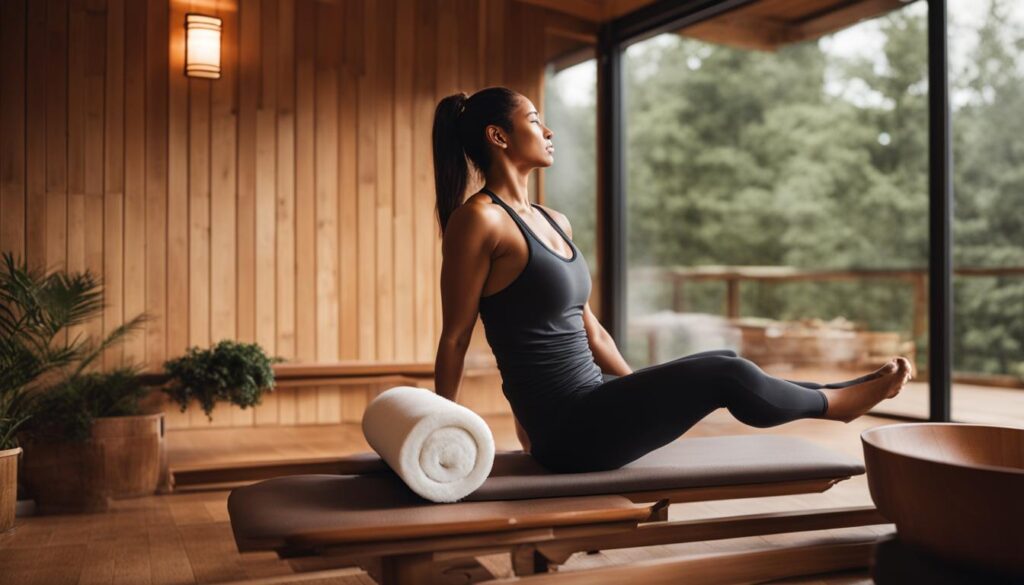
Low-Impact Exercise Tips for Injury Recovery and Fitness Maintenance
When you start low-impact exercises for healing and keeping fit, listening to your body is key. You also need to keep your form right. And always follow what healthcare pros say. By doing this, you can enjoy the gains without risking more harm.
Injury recovery tips: Cross-training helps keep fit while your injury heals. You can tweak exercises to avoid stress on the hurt part. Make sure to balance rest and exercise. This helps heal without delaying recovery.
Fitness maintenance tips: Even if you’re not hurt, low-impact exercises are good for staying fit. They’re easy on your body but still boost heart health and muscle strength. Don’t forget to care for your mental health by staying upbeat and focusing on what you achieve.
Keep these fitness maintenance tips in mind for effective healing and to come back strong. Always get advice from healthcare experts and track your healing. This ensures your come back is safe and strong.